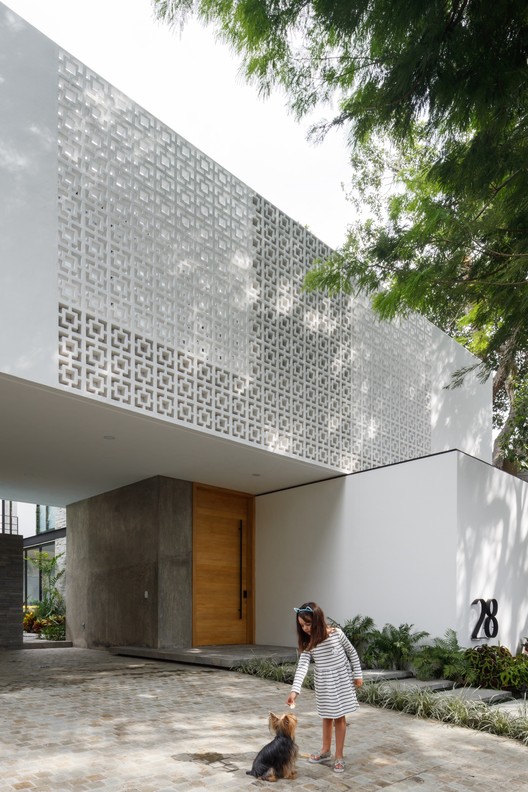Escobar Renovation Chen + Suchart Studio
2016-11-23 17:00
© Matt Winquist
MattWinquist


架构师提供的文本描述。埃斯科瓦尔酒店坐落在20世纪30年代被称为F.Q.故事的街区,它代表了亚利桑那州凤凰城少有的几个可以称之为历史性的地区之一的特色和风味。构成这一社区的602所住宅中的大多数仍然保留着使这一地区独特的各种建筑风格。这一地区的住房明显比今天的平均住房小。
Text description provided by the architects. Sited in the 1930’s era neighborhood known as F.Q. Story, the Escobar Renovation represents the character and flavor of one of very few areas in the young city of Phoenix, Arizona that can be called historic. The majority of the 602 homes that comprise this neighborhood still retain the varying architectural styles that make this district unique. Homes in this area are distinctly smaller than today’s average homes.
© Matt Winquist
MattWinquist


Escobar装修是对现有住宅的翻新,其建筑风格可以归类为英国都铎风格。除了一个小储藏室外,这座房子几乎100年都没动过。因此,家庭空间提供了一个非常不同的需要,表明了那个时代。现有的1100平方英尺(SF)住宅被分隔成许多不同的空间,每个空间彼此封闭。凤凰城的法规和指导方针要求,任何新的外部工作都必须保持这个家园和社区的历史特征。
The Escobar Renovation is a renovation to an existing home whose architectural style can be categorized as having an English Tudor style. With the exception of a small storage closet, this home has largely remained untouched for nearly 100 years. As a result, the spaces of the home served a very different need indicative of that era. The existing 1,100 square foot (SF) house was separated into many different spaces each being closed off from one another. Codes and guidelines mandated by the City of Phoenix required that any new work to the exterior maintain the character of the historic qualities of this home and neighborhood.
© Matt Winquist
MattWinquist




© Matt Winquist
MattWinquist


我们关于翻新和扩建现有住宅的建议深深植根于一种建筑,这种建筑在美学和功能上符合当今时代客户的需求。在公共区域的主要空间,这一决定是为了让同样的足迹在规划上和剖面上都显得更加广阔。现有公共区域的所有墙壁都被拆除,以推广一个更大的空间,客厅、厨房和餐饮区成为一个统一的空间。利用现有的阁楼空间,进一步扩大了空间的统一性。允许在起居室上方有一个拱形区域,同时返回厨房和餐饮区原来的天花板高度。这个空间进一步向外扩展到后院区域,在那里,内部和外部空间合并为一个空间,由可操作的滑动玻璃门连接在一起。天花板平面上的连续曲折移动有助于扩大现有空间的感觉。空间可以被看作是更大的东西。(鼓掌)
Our proposal for the renovation and addition to the existing home is deeply rooted in an architecture that is aesthetically and functionally of our client’s needs in today’s era. In the main space of the public area, the decision was made to make the same footprint feel more expansive both in plan and in section. All the walls of the existing public areas were removed to promote one larger space where the living room, kitchen and dining area became one unified space. This unification of space was further expanded upon by taking advantage of the existing attic space as well, allowing for a vaulted area over the living room while returning to the original ceiling height for the kitchen and dining area. This space further expanded outwards to the backyard area where the interior and exterior spaces merge as one space joined by operable sliding glass doors. The continuous sinuous move in the ceiling plane serves to expand the sense of the space where the existing space could be perceived as something much larger.
© Matt Winquist
MattWinquist


主卧室和浴室的增加发生在新建400 SF的建筑中。从根本上讲,与这座历史住宅的连接需要与现有住宅的语言进行对话,而不是一个不同时代的传真。从类型上讲,这一增加是对现有住宅的同情,同时也是一种明显的新东西。作为一种开放的门廊形式。全高度的玻璃门和可操作的玻璃滑动门在这种形式的挤压内通向一个封闭的露台。一个悬臂混凝土露台和人行道将新的有盖的露台和一个类似语言的有盖的露台结合在一起,与就餐和厨房区域相邻。这个附加部分还包括新的主浴室,在门式刚门的地方。空间在保持隐私的同时,向天窗扩展。加盖上标准的22 ga立缝金属系统,加上木炭kynar 500饰面。面板继续垂直从墙壁表面延伸到屋顶表面,作为加法的一种统一的物质性。这个金属山墙的末端的配置进一步重新构思了门式体的图示。(鼓掌)
The addition of a master bedroom and bathroom occur within the construction of the new 400 SF addition. Fundamentally, connection with the historic home needed to engage in a dialogue with the existing home’s language without being a facsimile of a different era. Typologically, the addition is sympathetic to the existing home while distinguishing itself as something distinctly new, as an open ended gabled form. Full height glazing and operable glass sliding doors lead out to an enclosed patio within the extrusion of this form. A cantilevered concrete patio and walkway unify the new covered patio with a covered patio of a similar language located adjacent to the dining and kitchen area. This addition also contains the new master bathroom where the gabled space expands skyward to a skylight while retaining privacy. The addition is clad with a standard 22ga standing seam metal system with a charcoal kynar500 finish. The panels continue vertically from wall surface to become the roofing surface as one unified materiality for the addition. The configuration of the end of this metal gable further reconceptualizes the iconography of the gabled form.
© Matt Winquist
MattWinquist


在当前的时间范围内,一个人如何与一个非常不同时代的语言互动,那么它是否是现代的呢?Escobar的革新提出了一些关于语言和图像学的问题,这是在20世纪30年代的时代背景下提出的。一个植根于近100年后的时代的建筑的提出,成为了这个项目的挑战。我们的改造试图在现有语言的范围内运作,同时建立一种截然不同的语言。这一对话将家庭现有语言和当前语言结合起来,其空间品质,因此,涉及到对现代和传统家园的形象的看法。(鼓掌)
How does one interact with the language of a much different era within the context of the current time period, and can it be modern? The Escobar Renovation proposes questions about language and iconography within the context of a 1930’s era home. The proposition of an architecture which is rooted in an era nearly 100 years later became the challenge of this project. Our renovation sought to work within the confines of the existing language while establishing a distinctly different language. This dialogue being engaged unifies both the existing and current languages of the home, the spatial qualities and as a result, engages the perceptions of the iconography of both the modern and traditional home.
© Matt Winquist
MattWinquist






















































Architects Chen + Suchart Studio
Location Phoenix, United States
Category Renovation
Architect in Charge Chen + Suchart Studio
Team Patricia Chen Suchart and Thamarit Suchart
Area 63.0 m2
Project Year 2016
Photographs Matt Winquist
Manufacturers Loading...































